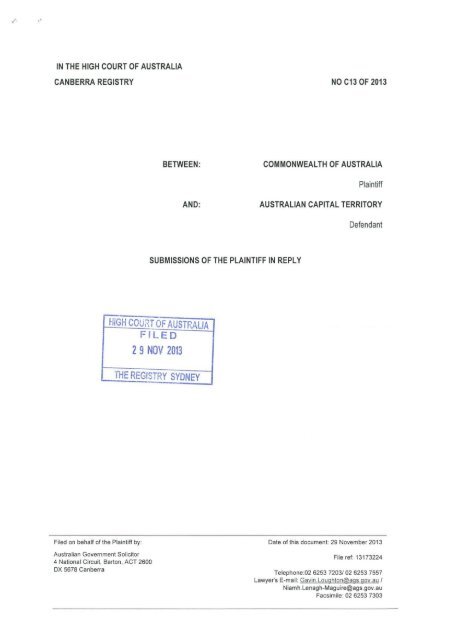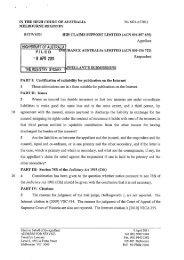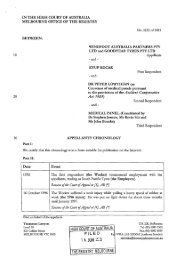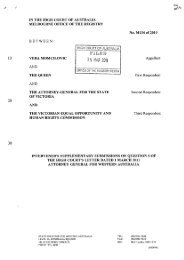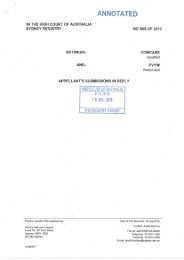Reply - High Court of Australia
Reply - High Court of Australia
Reply - High Court of Australia
You also want an ePaper? Increase the reach of your titles
YUMPU automatically turns print PDFs into web optimized ePapers that Google loves.
IN THE HIGH COURT OF AUSTRALIA<br />
CANBERRA REGISTRY<br />
NO C13 OF 2013<br />
BETWEEN:<br />
COMMONWEALTH OF AUSTRALIA<br />
Plaintiff<br />
AND:<br />
AUSTRALIAN CAPITAL TERRITORY<br />
Defendant<br />
SUBMISSIONS OF THE PLAINTIFF IN REPLY<br />
HIGH COU:tT OF AUSTRALIA<br />
FILE D<br />
2 9 NOV 2013<br />
THE REGISTRY SYDNEY<br />
Filed on behalf <strong>of</strong> the Plaintiff by:<br />
<strong>Australia</strong>n Government Solicitor<br />
4 National Circuit, Barton, ACT 2600<br />
OX 5678 Canberra<br />
Date <strong>of</strong> this document: 29 November 2013<br />
File ref: 13173224<br />
Telephone:02 6253 7203/ 02 6253 7557<br />
Lawyer's E-mail: Gavin.Loughton@ags.gov.au I<br />
Niamh.Lenagh-Maguire@ags.gov.au<br />
Facsimile: 02 6253 7303
'•<br />
PART I<br />
FORM OF SUBMISSIONS<br />
1. These submissions are in a form that is suitable for publication on the internet.<br />
PART II<br />
ARGUMENT<br />
2. These submissions use the same abbreviations as in the Commonwealth's submissions in chief<br />
(CS). The parties differ on two matters: First, do the Marriage Act and the FLA exhaustively set out<br />
a uniform set <strong>of</strong> rules for <strong>Australia</strong> on the essential and formal characteristics <strong>of</strong> marriage, the<br />
bringing to an end <strong>of</strong> marriage and the resolution <strong>of</strong> matrimonial causes; or do such Acts deal only<br />
with one form <strong>of</strong> marriage, 'traditional marriage', and leave it open to the States and Territories to<br />
identify and make lawful as many other forms <strong>of</strong> marriage- varying the integers <strong>of</strong> 'traditional<br />
1 o marriage'- as appeal to them from time to time? Has the boundary in law between 'married' and<br />
'unmarried' been left by the Commonwealth laws infinitely moveable, in the discretion <strong>of</strong> the States<br />
and Territories? Secondly, if the ACT Marriage Act, by purporting to create a parallel status <strong>of</strong><br />
'marriage', would be inconsistent with the Marriage Act and the FLA under s 109 <strong>of</strong> the<br />
Constitution, does s 28 <strong>of</strong> the ACT Self-Government Act produce a different result?<br />
3. Before replying to the submissions <strong>of</strong> the Defendant (ACT) and the proposed intervener (AME)<br />
regarding those matters, it is convenient to address the constitutional issue regarding the reach <strong>of</strong><br />
s 51(xxi). In that regard, there first arises a question as to which constitutional question it is<br />
necessary to decide. The Commonwealth submits that, even on a narrow view <strong>of</strong> the power, a<br />
Commonwealth law could validly state that certain defined unions and no others are to bear the<br />
20 status <strong>of</strong> marriage.' Only if that argument were rejected would it be necessary for the <strong>Court</strong> to<br />
determine the larger constitutional question.<br />
A. Reach <strong>of</strong> the Marriage Act and FLA<br />
4. Genera/ construction issues There are three aspects <strong>of</strong> the overall approach <strong>of</strong> the ACT and<br />
AME to construction that should be rejected. First, the persistent attempt to find the narrowest<br />
possible basis to read the Commonwealth law, being a scheme which, as is apparent from the text,<br />
context and statutory object, was enacted on the basis that marriage is a genus crying out for<br />
uniform regulation in relation to the attaining <strong>of</strong> the status. Instead <strong>of</strong> following the logical<br />
implications <strong>of</strong> the text and apparent statutory purpose, it is said that the regulation <strong>of</strong> that status<br />
(and its loss and other consequent causes under the Matrimonial Causes Act or the FLA) should<br />
30 be understood as dealing only with a particular form <strong>of</strong> status at the time <strong>of</strong> those enactments. That<br />
seemingly invites this <strong>Court</strong> to apply some form <strong>of</strong> contemporanea expositio principle <strong>of</strong><br />
construction. That has long been abandoned in <strong>Australia</strong> as a generally applicable approach' and<br />
is inapposite in the context <strong>of</strong> the Marriage Act.' Marriage is a dynamic and developing institution,<br />
a matter that was well understood and anticipated at the time <strong>of</strong> the enactment <strong>of</strong> the Marriage<br />
Acl. 4 And as such, it is inherently unlikely that Parliament intended to provide for what AME<br />
accepts was a single Federal code by reference solely to the metes and bounds <strong>of</strong> the law or<br />
institution <strong>of</strong> marriage frozen in time as at 1961, such that its initial uniformity could be whittled<br />
'AME's submission atl17]to the contrary is incorrect. All that is required is a sufficient connection with the subject matter <strong>of</strong> 'marriage'. The<br />
marriage power allows Parliament to prescribe what unions are to be regarded as 'marriage': Attorney-Genera/ <strong>of</strong> NSW v Brewery<br />
Employees Union <strong>of</strong> NSW (1908) 6 CLR 469 at610. If the power is to be efficacious, that necessarily involves saying what marriage is not.<br />
By analogy, the banking power authorises a Commonwealth law that prevents a body that is not licensed as a bank, and could nol<br />
constitutionally be a bank, from using 'bank' or 'banking' in carrying on a financial service (Banking Act 1959 (Cth), s 66). To take a closer<br />
example, the marriage power plainly extends to the prohibition <strong>of</strong> polygamous marriage, the regulation <strong>of</strong> its effects and the creation <strong>of</strong><br />
associated <strong>of</strong>fences, whether or not it would be within the power <strong>of</strong> the Commonwealth to make polygamy lawful throughout <strong>Australia</strong>:<br />
Attorney-Genera/ (Vic) v The Commonwealth (1961) 107 CLR 529, particularly at 577 per Windeyer J. The same is true <strong>of</strong> same sex<br />
marriages.<br />
2 See eg Stingel v Clarke (2006) 226 CLR 442 at458-459127] per Gleeson CJ, Callinan, Heydon and Grennan JJ and The Council <strong>of</strong>the<br />
Shire <strong>of</strong> Lake Macquarie v Aberdare County Council (1970) 123 CLR 327 at331 per Barwick CJ (Menzies J agreeing at332].<br />
3<br />
As was held in Attorney-General (Cth) v Kevin (2003) 172 FLR 300 (upon which the ACT relies at ]52]) at362-330 1365]-]371].<br />
4 Attorney-General (Vic) v The Commonwealth (1961]107 CLR 529 at577, 579-580 per Windeyer J.<br />
Submissions <strong>of</strong> the Plaintiff in reply Page 1
10<br />
5.<br />
away as the law was further developed by the States and Territories.<br />
The second key error, particularly in the submissions <strong>of</strong> the ACT, is to dismiss the reason for the<br />
insertion <strong>of</strong> the marriage power in the Constitution and the extrinsic materials regarding the<br />
subsequent exercise <strong>of</strong> that power as irrelevant to the task <strong>of</strong> construction. Viewed correctly, the<br />
extrinsic materials and the historical context usefully illuminate the objective statutory purpose <strong>of</strong><br />
the Marriage Act, which was to exhaustively codify for <strong>Australia</strong> the law <strong>of</strong> marriage both at the<br />
time <strong>of</strong> that enactment and prospectively: see CS [11]-[19]. The very authorities upon which the<br />
ACT relies for the contrary proposition make plain that such material may be used for that task.s<br />
Identification <strong>of</strong> such a purpose is not logically congruent with that <strong>of</strong> 'subjective purpose or<br />
intention' (contra ACT [42]), even if the two coincide.• Those matters, and the broader historical<br />
context, point to the mischief to be addressed by the Marriage Act 7 and, indeed, the reason for the<br />
insertion <strong>of</strong> the power ins 51 in the first place. It is erroneous to put all <strong>of</strong> that to one side and<br />
pretend that the process <strong>of</strong> statutory construction may be conducted with the Act in one hand and<br />
a dictionary in the other.• And none <strong>of</strong> that involves 'inconsistency <strong>of</strong> political opinion' (contra ACT<br />
[43]). As was explained in Momcilovic v The Queen,' the question is rather whether, applying<br />
orthodox rules <strong>of</strong> construction, a federal law is a complete statement <strong>of</strong> the law governing a<br />
particular matter so as to give rise to what Gum mow J termed an 'implicit negative proposition' that<br />
nothing other than what the Federal law provides on that subject matter is to be the subject <strong>of</strong><br />
State or Territory legislation.<br />
20 6. The third key error, made by the ACT but not AME, is to construe Commonwealth enactments as<br />
objectively intended to have a narrower operation in the Territory than across the Commonwealth<br />
as a whole.<br />
30<br />
40<br />
7.<br />
8.<br />
Definition ins 5(1) The role <strong>of</strong> the definition <strong>of</strong> 'marriage' ins 5(1) <strong>of</strong> the Marriage Act is to confirm<br />
what was implicit in any event, namely that the core essential requirements for the validity <strong>of</strong><br />
marriage under the law <strong>of</strong> <strong>Australia</strong> are the four matters there specified. The specification <strong>of</strong> each<br />
<strong>of</strong> those four essential requirements, in this particular statutory context, necessarily excludes other<br />
variants from that status. And that is so regardless <strong>of</strong> whether the Commonwealth enactment<br />
imposes 'express prohibitions' or rules requiring that people abstain from entry into those variants.<br />
The Marriage Act prescribes the rules regulating marriage, and they are uniform and exhaustive for<br />
those who wish to acquire that status in the <strong>Australia</strong>n community. The position was aptly<br />
summarised by Pr<strong>of</strong>essor Hart, who observed:<br />
... some rules are mandatory in the sense that they require people to behave in certain ways e.g. abstain<br />
from violence or pay taxes, whether they wish to or not; other rules such as those prescribing the<br />
procedures, formalities and conditions for the making <strong>of</strong> marriages, wills and contracts indicate what<br />
people should do to give effect to the wishes they have. 10<br />
The ACT and AME fail to grapple with the effect <strong>of</strong> the definition ins 5(1); nor do they explain what<br />
alternative role it might sensibly be given in the context <strong>of</strong> the statute. Rather, they seek to<br />
advance the startling proposition that it has confirmed that the Marriage Act does nothing more<br />
than regulate unions falling within that 'expressly self-limited' definition: a union between a man<br />
and woman to the exclusion <strong>of</strong> others, voluntarily entered into for life." Again, the contest between<br />
'See, in addition to Laceyv Affomey-General (OLD) (2011) 242 CLR 573 at [44] and Certain Lloyd's Underwrilers v Cross (2012) 87 ALJR<br />
131 at 138 [25] per French CJ and Hayne J, Akiba v Commonwea/Jh (2013) 87 ALJR 916 at 925 [31] per French CJ and Grennan J and Lee<br />
v New Soulh Wales Crime Commission (2013) 302 ALR 363 at 386 [45] per French CJ. See also the discussion <strong>of</strong> the 'modern approach to<br />
statutory interpretation' in GIG Insurance Limited v Bankstown Football Club Limited (1997) 187 CLR 384 at 408.<br />
'Lee v New Soulh Wales Crime Commission (2013) 302 ALR 363 at 386 [45] per French CJ.<br />
7 See eg Network Ten Ply Limited v TCN Channel Nine (2004) 218 CLR 273 at [11[-[12).<br />
8 APLA Ltd v Legal Services Commissioner for New South Wales [2005) 224 CLR 322 at 462 [423] per Hayne J.<br />
'(2011) 245 CLR 1 at 111 [244].<br />
10 The Concept <strong>of</strong> Law (Oxford University Press, 1" ed, 1961) p 9.<br />
11<br />
AME [55], see also [52], ACT [29], [32] and [55].<br />
Submissions <strong>of</strong> the Plaintiff in reply Page 2
these competing views is to be resolved by the application <strong>of</strong> orthodox principles <strong>of</strong> statutory<br />
interpretation. The Commonwealth's submissions are supported by, and the alternative view<br />
denied by, the text <strong>of</strong> the definition (CS [35]), the purpose <strong>of</strong> the provision (CS [34]) within the<br />
broader purpose <strong>of</strong> the Marriage Act (CS [16]-[19],[23])), and the context within which it operates,<br />
especially having regard to s 6 (CS [22]), s 46(1) (CS [20.1 ]), and the provisions generally <strong>of</strong><br />
Division 2 <strong>of</strong> Part IV (see below [11]-[12]).<br />
9. Further telling against the construction proposed by the ACT and AME, s BBEA (which was<br />
inserted with the definition ins 5(1)) would, on their proposed construction, involve some form <strong>of</strong><br />
anomalous discrimination against persons who married in another country: see CS [36]. The fact<br />
1 o that s BBEA was inserted by the very same amending Act which added the definition to s 5(1)<br />
confirms the opposite is true: if a same sex marriage took place outside <strong>Australia</strong>, it would not be<br />
recognised; and the addition <strong>of</strong> s 5(1) put beyond any doubt that such a marriage could not take<br />
place under the uniform law <strong>of</strong> marriage in <strong>Australia</strong>." The definition obviated the need for a further<br />
express provision like s BBEA to apply to unions solemnised in <strong>Australia</strong>. Moreover, if the ACT and<br />
AME are correct, the use <strong>of</strong> any one <strong>of</strong> the ingredients <strong>of</strong> the definition in s 5(1) could be used to<br />
develop a statutory cocktail at the State or Territory level with absurd results: eg same-sex,<br />
temporary, polygamous, involuntary, underage or incestuous marriages.<br />
10. Section 238 <strong>of</strong> the Marriage Act The ACT and AME also radically overstate the significance <strong>of</strong><br />
the grounds for void marriages under s 238(1) <strong>of</strong> the Marriage Act and the fact that the Marriage<br />
20 Act does not specifically designate same sex relationships as 'prohibited relationships' for the<br />
purposes <strong>of</strong> s 238(2). 13 First, as to prohibited relationships, that submission overlooks the subject<br />
matter <strong>of</strong> s 238(2), which concerns the prohibited degrees <strong>of</strong> consanguinity and (to the extent<br />
adoptive children do not fall within that notion) affinity. That is, it involves a second order essential<br />
requirement, regarding whether there exists a matter <strong>of</strong> blood or relationship that the law considers<br />
too close. One would hardly expect the question <strong>of</strong> whether same sex parties could marry would<br />
be dealt with in such a provision.<br />
11. Secondly, it is well established that there are in fact three possibilities in respect <strong>of</strong> any ceremony<br />
<strong>of</strong> marriage: it may be valid; it may be void by reason <strong>of</strong> s 238(1) or it may be no marriage at all."<br />
Obiter observations <strong>of</strong> the Family <strong>Court</strong> correctly include same sex marriage in the last mentioned<br />
30 category. 15 So too would be temporary marriages. The search for an 'express prohibition' as<br />
regards such unions is therefore futile. They are simply excluded from the status <strong>of</strong> marriage by<br />
the implicit negative proposition that appears from the terms, nature and subject matter <strong>of</strong> the<br />
Marriage Act.<br />
12. Thirdly, the suggestion that an approach 'akin to the principle <strong>of</strong> legality' is to be applied is similarly<br />
misplaced (AME [68]). Little assistance is derived from seeking to invoke a general presumption<br />
against the very thing the Act seeks to achieve.'•<br />
13. Division 2 <strong>of</strong> Part IV A third specific issue separating the parties concerns Division 2 <strong>of</strong> Part IV.<br />
The question is whether it is confined to prescribing the procedures, formalities and conditions for<br />
the valid formation <strong>of</strong> some (but by no means all) kinds <strong>of</strong> marriages, ie those which happen to<br />
40 answer the description ins 5(1) <strong>of</strong> the Act (as submitted by the ACT and AME); or whether it rather<br />
provides a code which applies to any union which seeks to confer upon the parties the status <strong>of</strong><br />
12 The decision <strong>of</strong> the Full Family <strong>Court</strong> the year before in Afforney-General (Cth) v Kevin (2003) 172 FLR 300 might have given focus to the<br />
question (see at 3251126]-[127] and [132], 236-71137)-[138] and 362-31366]-[371]), although it was not an issue in the case (see at 17 [67)).<br />
13 AME at [56].<br />
14 Sees 113 <strong>of</strong> the FLA and In the Marriage <strong>of</strong>VK and Kapadia [1991) 14 Fam LR 883 at 886-887; Dina/ and Tohim (No 2) [2009] Fam CA<br />
540 at [39]; Carroll and Sinclair 12011] FamCA 651 at 122]-[26]. See also, in the United Kingdom, R v Bham 11965]1 QB 159.<br />
15 /n the Marriage <strong>of</strong> VK and Kapadia (1991) 14 Fam LR 883 at 886: 'If the parties are not <strong>of</strong> the opposite sex, there is no marriage.'<br />
16 Lee v NSW Crime Commission (2013) 302 ALR 363 at 4521314] per Gageler and Keane JJ. In any event, the materials noted at CS [34]<br />
show that the Commonwealth Parliament clearly confronted what it was doing and that it accepted the political cost.<br />
Submissions <strong>of</strong> the Plaintiff in reply Page 3
'married persons' at general law; i.e. persons who are properly described as 'married' and to whom<br />
the law annexes peculiar legal rights, duties, capacities and incapacities. The correct view is the<br />
latter: the Division sets out the formal requirements designed to carry into effect the singular notion<br />
<strong>of</strong> marriage for the whole law <strong>of</strong> <strong>Australia</strong>, which has been identified through the essential<br />
requirements ins 5(1). The text <strong>of</strong> ss 40(1) and 48(1) points to the fact that the ACT's and AME's<br />
submissions regarding s 5(1) involve a red herring: 21! marriages solemnised in <strong>Australia</strong> are to be<br />
solemnised in accordance with that Division" and not otherwise, because the only marriages that<br />
may be solemnised in <strong>Australia</strong> are the marriages which are permissible under the Act (s 5(1)<br />
marriages)." Other purported unions are simply not marriages at all (including same sex and<br />
10 temporary marriages) or void (bigamous and involuntary marriages).<br />
14. The tie between the essential requirements ins 5(1) and the uniform formal requirements for<br />
solemnisation <strong>of</strong> marriages in <strong>Australia</strong> is also evident. This can be seen in the notion <strong>of</strong> a common<br />
set <strong>of</strong> authorised celebrants for marriage in <strong>Australia</strong> (s 41 ); a common set <strong>of</strong> notification<br />
provisions which are designed to enable the parties to disclose and the authorised celebrants to<br />
verify whether the essential requirements are satisfied (s 42); 19 a common standard for public<br />
witnessing (s 44); a common form <strong>of</strong> ceremony (with some flexibility to allow for religious variations<br />
- s 45); and a common statement at ceremonies not solemnised by a minister <strong>of</strong> a religion <strong>of</strong> a<br />
recognised denomination which affirms that marriage, for the law <strong>of</strong> <strong>Australia</strong>, has the<br />
requirements <strong>of</strong> the definition ins 5(1) (s 46(1)). The importance <strong>of</strong> those various formal<br />
20 requirements is carried through by the recognition in s 48 that the contravention <strong>of</strong> at least some<br />
will result in the marriage being void.<br />
B. ACT Marriage Act is inconsistent with the Marriage Act and the FLA<br />
15. Test <strong>of</strong> inconsistency: The central error in the ACT submissions regarding this issue is to seek to<br />
draw an analogy between s 28 <strong>of</strong> the ACT Self-Government Act and a Commonwealth provision<br />
stating that a Commonwealth Act is not intended to exclude State laws that are capable <strong>of</strong><br />
operating concurrently (contra ACT [12]). When a 'concurrent operation provision' is inserted into<br />
a Commonwealth Act it may assist in arriving at a conclusion that that Act is not intended to be an<br />
exhaustive statement <strong>of</strong> the law on a particular topic for <strong>Australia</strong> and, in turn, may inform the<br />
interpretation <strong>of</strong> other provisions <strong>of</strong> the same Act. The purpose <strong>of</strong> s 28 in an Act conferring powers<br />
30 on a subordinate legislature is to place a limit on that power so that, as between two separate laws<br />
which conflict, it is the law <strong>of</strong> the primary legislature which prevails. While concurrency is specified<br />
as the test for the identification <strong>of</strong> inconsistency, concurrency is not ascertained by modifying the<br />
true operation <strong>of</strong> the laws <strong>of</strong> the primary legislature. It may, depending upon the circumstances,<br />
inform the interpretation <strong>of</strong> ACT taws, by permitting them to be 'read down' to avoid an<br />
inconsistency.'"<br />
16. The correctness <strong>of</strong> that view is confirmed by the context. Under s 34(4) <strong>of</strong> the ACT Self<br />
Government Act, subject to certain exceptions, the previous ACT ordinances were converted into<br />
'enactments' on the basis that Commonwealth Acts continued to operate fully in the Territory.<br />
Equally it would be a bizarre result if s 28 meant that (as at that date) uniform Commonwealth laws<br />
40 intended to be exhaustive statements <strong>of</strong> law on particular subject matters were rolled back to<br />
enable the ACT to pass enactments so as to alter, impair or detract from that uniformity.<br />
17. In examining any argument concerning possible concurrency, it remains critical to properly<br />
17<br />
Or Division 3 <strong>of</strong> Part IV.<br />
18<br />
See also the long lille: An Act relating to marriage.<br />
"See also the Marriage Regulations 1963 (Cth) which prescribe the form <strong>of</strong> notice (by Form 13) to be given pursuant to s 42 and the form<br />
<strong>of</strong> declaration by a party to a proposed marriage (by Form 14).<br />
20 See, by way <strong>of</strong> analogy, Webster v Macintosh (1980) 32 ALR 603 at 605. Writing extra-judicially, Justice Leeming has suggested that a<br />
further analogy may be seen ins 73 <strong>of</strong> the Aboriginal Land Rights (Norlhem Territory) Act 1976 (Cth) considered in Gumana v Norlhem<br />
Territory (2007) 158 FCR 349 at [103[ (see M Leeming, Resolving Conflicts <strong>of</strong> Laws (Federation Press, 2011) pp 240-241).<br />
Submissions <strong>of</strong> the Plaintiff in reply<br />
Page4
construe the law <strong>of</strong> the primary legislature. Where, as here, that law is intended to provide an<br />
exhaustive statement <strong>of</strong> law on the topic which operates uniformly across <strong>Australia</strong>, an ACT law<br />
will necessarily be incapable <strong>of</strong> concurrent operation when it purports to introduce variation in the<br />
law for cases concerned with the ACT when such variation would not be permitted in any <strong>of</strong> the<br />
States. And even if it were otherwise, the effect <strong>of</strong> the 2004 amendments was to impliedly repeal<br />
s 28 to that extent.<br />
18. A further error in the ACT's argument is that it would mean that the Commonwealth can only<br />
legislate to the exclusion <strong>of</strong> ACT laws by expressly excluding those laws, or (previously) by<br />
exercising the power to disallow ACT laws (ACT [14], [16]). But there is no requirement that an<br />
10 intention <strong>of</strong> a Commonwealth law to operate to the exclusion <strong>of</strong> State and Territory laws be stated<br />
expressly; this intention can be discerned under the usual rules <strong>of</strong> interpretation .2 1 And removing<br />
inconsistency between Commonwealth and ACT laws is not just a matter between polities, but also<br />
protects citizens by ensuring they are not subject to inconsistent commands. 22 It cannot be<br />
dependent on the exercise <strong>of</strong> a disallowance power.<br />
19. Uncertainty and complexity: The assertion that the ACT Marriage Act will not reintroduce the<br />
'scandal' deprecated in Fremlin v Fremlin23 does not withstand analysis. A relationship created by<br />
an ACT law cannot operate <strong>of</strong> its own force in other law areas <strong>of</strong> <strong>Australia</strong> (despite s 6 <strong>of</strong> the ACT<br />
Marriage Act) -its recognition outside the ACT will therefore depend on the operation <strong>of</strong> other<br />
rules (particularly rules <strong>of</strong> private international law). This will inevitably lead to uncertainty and<br />
20 complexity. For example, if a couple are married in the ACT, but a dispute later arises in a State,<br />
say NSW, issues will arise with whether their marriage is to be recognised in that State, both<br />
generally and for the purpose <strong>of</strong> State legislation that uses 'marriage' as an operative status .24<br />
Also, the notion that persons could have the status <strong>of</strong> 'married' under ACT law but 'de facto' under<br />
Commonwealth law is the very consequence that the Commonwealth Acts were enacted to avoid<br />
(contra ACT [60]). Private international law rules whether based upon domicile or otherwise will<br />
need to be revivified. In so doing, the ACT Marriage Act shatters the uniformity intended by<br />
Commonwealth Acts and purports to subordinate their norms to its norm.<br />
Dated: 29 November 2013<br />
t::!!;.~;~<br />
Solicitor-General <strong>of</strong> the Commonwealth<br />
Telephone: 02 6141 4145<br />
Facsimile: 02 6141 4149<br />
Email: justin.gleeson@ag.gov.au<br />
Michael Kearney SC<br />
Telephone: 02 9264 8444<br />
Facsimile: 02 9264 8944<br />
E: kearneysc@waratahchambers.com.au<br />
30<br />
Craig Lenehan<br />
Telephone: 02 8257 2530<br />
Facsimile: 02 9221 8387<br />
Email: craig.lenehan@stjames.net.au<br />
Graeme Hill<br />
Telephone: 03 9225 6701<br />
Facsimile: 03 9640 3108<br />
Email: graeme.hill@vicbar.com.au<br />
Counsel for the Commonwealth<br />
21 See eg O'Sullivan v Noarlunga Meat Ltd (1954) 92 CLR 565 at 591 (Fullagar J, with Dixon CJ and Kitto J agreeing): the 'extremely<br />
elaborate and detailed set <strong>of</strong> requirements' contained in the Commonwealth regulations excluded State regulations <strong>of</strong> that subject.<br />
22 See Dickson v The Queen (201 0) 241 CLR 491 at 503-504 [19] (the <strong>Court</strong>).<br />
23 (1913) 16 CLR 212; CS [15]. Contra ACT [41]. [53].<br />
24 For example, Succession Act 2006 (NSW), s 12 (a will is revoked by the 'marriage' <strong>of</strong> the testator); Property (Relationships) Act 1984<br />
(NSW), s 4(1)(b) (definition <strong>of</strong> 'de facto relationship' excludes people who are married) ; Married Persons (Equality <strong>of</strong> Status) Act 1996<br />
(NSW), s 13 (a 'spouse' can apply to recover his or her money that was invested without his or her consent by the other spouse).<br />
Submissions <strong>of</strong> the Plaintiff in reply Page 5
ERRATA<br />
CORRECTIONS TO COMMONWEALTH'S SUBMISSIONS DATED 13 NOVEMBER 2013<br />
Page 3, footnote 7:<br />
For "h thaf' read "Thaf'<br />
Page 10, para 20.2:<br />
For "18 for females and 16 for males" read "16 for<br />
females and 18 for males"<br />
Page 10, para 20.2<br />
For "a position that previously applied only in South<br />
<strong>Australia</strong>" read "a position that previously applied<br />
only in South <strong>Australia</strong>, Tasmania and Western<br />
<strong>Australia</strong>"<br />
Page 16, para 42 (last line):<br />
For "under Part <strong>of</strong> the Domestic Relationships<br />
Act 1984" read "under Part 3 <strong>of</strong> the Domestic<br />
Relationships Act 1994"<br />
A2633794 - v1.0


